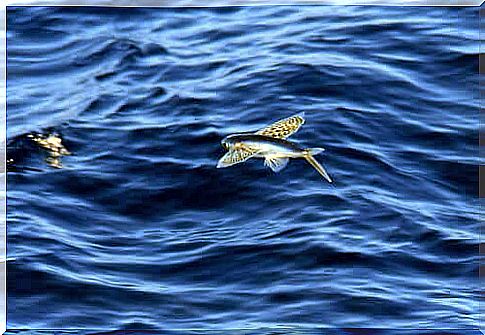Flying Fish: Trivia And Features

Flying fish are a curiosity in the animal world, which aroused the interest of researchers and navigators for many centuries. The characteristic that makes these species unique is precisely their ability to fly over the ocean surface for very long distances.
There are over 70 different types within the flying fish family, the Exocoetidae . These 70 types are grouped into nine genera, yet all share similar characteristics.
Flying fish have an aerodynamic constitution that allows them to reach high speeds. Their large pectoral fins help them glide over water and redirect the wind.
The flights of these fish are usually 50 meters. However, flights of more than 200 meters have already been registered. Some species with dilated pelvic fins can travel more than 400 meters over water.
None of the types of flying fish measure more than 30 centimeters. However, it is necessary to clarify that the size will depend on the species of flying fish. Some of the species with larger fins are those that inhabit tropical and subtropical waters off the west coast of the Atlantic Ocean.
The fins of some species are almost as long as the animal’s body.
Flying fish, an aerodynamic wonder
In general, researchers separate these fish into two broad categories: two-winged and four-winged fish. Two-winged fish are those that have very developed pectoral fins.
On the other hand, four-winged fish have equally developed pectoral and pelvic fins, which allows them to have greater maneuverability.

We have to make it clear that, in reality, flying fish don’t fly. A flying fish does not fly like a bird, but glides through the air with the help of its wide fins.
Some researchers have already suggested that the morphology of these fishes evolved in this way so that they could escape their predators. So, if the fish leaves the water, the hunt is over.
Some of the most common predators of flying fish are tuna and swordfish, although many others hunt them as well. Paradoxically, when leaving the water, a flying fish also becomes prey for the birds. This increases the risk of it being devoured.
In order to “fly”, these fish must reach a very high speed in the water. Flying fish can swim at a speed of up to 60km/h. When they reach that speed, they head for the surface at an angle not too steep.
Once they leave the surface of the water, flying fish spread their pectoral wings. At the same time, they keep flapping their tails to achieve greater momentum.
After this first moment, a flying fish can reach a height of several meters and glide over the surface of the water. Flying fish can stay out of the water for a long time, thanks to the movement of their tail fin. This fin flutters 50 to 70 times a second to boost the flight.

Habitat , food and reproduction
Flying fish inhabit shallow areas, even in waters far from the coast. In general, they are distributed over hot and tropical zones. There are also habitats in subtropical waters, although their morphology changes slightly.
Flying fish are found in many seas and oceans around the world, but mostly in the warm waters of the Atlantic Ocean. The Mediterranean Sea is home to many types.
The diet of flying fish consists mainly of plankton, very small living organisms that are suspended in water. Many other small fish also feed on plankton for a living. In addition to plankton, they feed on smaller fish.
The reproduction of flying fish is oviparous. Females lay eggs in algae or directly in water. The eggs are held together by a kind of elastic thread membrane. In the Asian market, the roe of these fish are considered a delicacy and are traded for a high value.
Currently, there are many tourist opportunities to watch the flying fish flying over the waters. In hot weather, many tourists enter tropical waters to observe this phenomenon.
Unfortunately, the numbers of these fish are decreasing considerably due to indiscriminate hunting. In Asia, flying fish are often caught for food. It is necessary to create adequate conservation measures for these species in the open sea.









